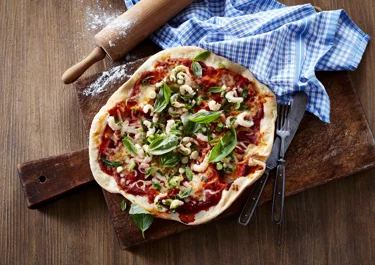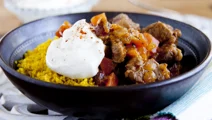
BBQ pizza with garlic marinated prawns

Instructions
Pizza dough - make one day ahead
Pizza dough - On the day of serving
Garlic marinated prawns
Recommended information
Serving suggestion
Ingredients
Pizza dough (to be made the day before)
Yeast | 10 g |
|---|---|
Water | 250 ml |
Olive oil | 2 tbsp |
Coarse salt | ¾ tsp |
Wholemeal durum flour | 125 g |
Strong white bread flour (also known as double zero flour or doppio 00 flour) | 250 g |
Pizza topping
Tomato sauce | 300 ml |
|---|---|
Grated mozzarella cheese 15% | 200 g |
For the barbecue
Large briquettes with high calorific value (about 2.5 kg) and for gas barbecues, use ceramic briquettes | 50 |
|---|
Garlic marinated prawns
Large prawns, cooked and peeled | 300 g |
|---|---|
Spring onions cut into thin rings | 150 g |
Small garlic cloves | 3 |
Lemons zest (unwaxed), finely grated | 2 tsp |
Freshly squeezed lemon juice | 2 tbsp |
Olive oil | 1½ tbsp |
Fresh basil | 1 handful |
Coarse salt to taste | |
Freshly ground pepper |
For serving
Fresh basil leaves to taste |
|---|
A smokin’ hot pizza
The perfect combination of juicy prawns, blended with fresh garlic and basil, all nestled on a bed of melted mozzarella cheese. Whether you’re a seafood lover or just looking for a new twist on traditional pizza, this garlic prawn pizza is sure to become a new summer favourite. Fire up the barbecue and get ready to sink your teeth into the crispy crust! Note: pizza dough should be made one day ahead.
Perfect for a late-night feast
Too late to fire up the barbecue? No problem. This pizza can just as easily be baked in an oven. Put two baking sheets to heat in the oven at about 250 °C, fan forced. Slide the pizza bases (untopped) onto the hot baking sheets and place at the top and bottom of the oven, about 10 minutes or until golden. Take out the pizza bases and spread on the tomato sauce and cheese. Bake the pizzas for six to eight minutes. until the cheese is golden and the bottoms are crispy.
Can BBQ sauce be used as pizza sauce?
In some situations, BBQ sauce can be used as a substitute for tomato sauce on a pizza. However, it has a distinct flavour – it’s usually sweeter, with a smoky, tangy flavour – that will change the overall taste of your pizza. BBQ sauce works well with toppings like chicken. If you’re using it for another dish that calls for tomato sauce, it might not be an appropriate substitute as the flavours will be very different.
Can I use foil to cook pizza on the barbecue?
Yes, using heavy-duty foil is a popular method for barbecuing pizza, especially for those who desire a crispy crust but are looking to avoid transferring a delicate pizza directly onto a barbecue grate.
Here’s how to successfully use heavy-duty foil (be sure to use heavy-duty foil to prevent tearing and to ensure that the pizza doesn’t stick to the foil):
- Cut a sheet of heavy-duty aluminium foil so it’s a little bit bigger than your pizza.
- Place the pizza dough on the foil and top with your desired sauce and toppings.
- Fold the edges of the foil up and around the pizza to form a sealed packet, leaving the top open.
- Place the foil packet on the grill and cook for around six minutes, or until the crust is crispy and the cheese is melted.
**Cooking times will vary depending on the temperature of your barbecue and the size of your pizza.
Do you need to oil a pizza stone before baking?
A pizza stone doesn’t need to be oiled or sprinkled with flour before baking. While not necessary, if you are worried about having your fresh dough sticking, you can line the stone with baking paper.
If you are using a new pizza stone, clean it beforehand by wiping it with a cloth that has been dampened with warm water
Never soak the pizza stone – water absorption will cause the stone to crack.
Can I cook pizza on the barbecue without a pizza stone?
Want the flavour and texture of a grilled pizza, but don’t have a pizza stone? Simply place the pizza directly on the grill. This method, however, is a little fiddlier and requires some finesse to prevent the crust from burning.
- Make sure your dough is well proofed. Follow the steps for shaping your pizza base listed in the recipe. Have all your ingredients ready to go before placing the pizza on the barbecue.
- We recommend placing the shaped pizza dough onto a floured pizza board or baking sheet (or a similar surface) to make it easier to slide onto the barbecue.
- Brush a little olive oil directly on to the grates or the pizza base to prevent the pizza from sticking or becoming overly charred.
- Slide the dough onto the barbecue grates. Cover the barbecue and wait for the bottom of the dough to cook. This will take around three minutes.
- Once the underside is cooked, lightly coat the top of the pizza with olive oil and gently (to avoid tearing the dough) use flat tongs or a spatula to flip the pizza over.
- Immediately top the cooked side with pizza sauce and cheese, time is of the essence here and you need the cheese to melt without burning the base. Don’t be too heavy handed with the toppings, you want to avoid a soggy base. Put down the barbecue cover and let the cheese melt for about one minute.
- Remove the pizza from the barbecue and top with the marinated prawns.











